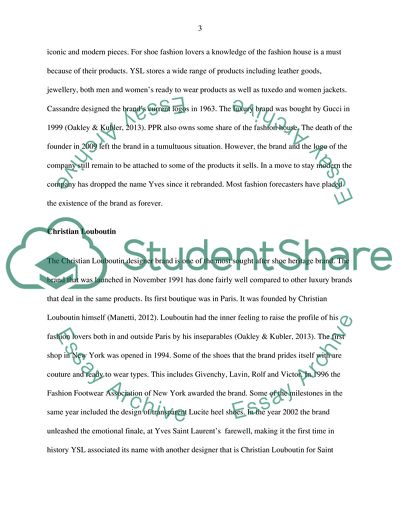Cite this document
(Yves Saint Laurent Red Ssoles Case Versus Christian Louboutin Luxury B Study, n.d.)
Yves Saint Laurent Red Ssoles Case Versus Christian Louboutin Luxury B Study. Retrieved from https://studentshare.org/marketing/1853938-comparing-the-retail-experience-of-two-luxury-brands-and-exploring-each-through-1-critically-reflecting-on-the-effective-strategies-of-fashion-marketing-and-retailing-of-each-brand-2-evaluating-the-purpose-of-store-location-and-its-support-of-brand-aware
Yves Saint Laurent Red Ssoles Case Versus Christian Louboutin Luxury B Study. Retrieved from https://studentshare.org/marketing/1853938-comparing-the-retail-experience-of-two-luxury-brands-and-exploring-each-through-1-critically-reflecting-on-the-effective-strategies-of-fashion-marketing-and-retailing-of-each-brand-2-evaluating-the-purpose-of-store-location-and-its-support-of-brand-aware
(Yves Saint Laurent Red Ssoles Case Versus Christian Louboutin Luxury B Study)
Yves Saint Laurent Red Ssoles Case Versus Christian Louboutin Luxury B Study. https://studentshare.org/marketing/1853938-comparing-the-retail-experience-of-two-luxury-brands-and-exploring-each-through-1-critically-reflecting-on-the-effective-strategies-of-fashion-marketing-and-retailing-of-each-brand-2-evaluating-the-purpose-of-store-location-and-its-support-of-brand-aware.
Yves Saint Laurent Red Ssoles Case Versus Christian Louboutin Luxury B Study. https://studentshare.org/marketing/1853938-comparing-the-retail-experience-of-two-luxury-brands-and-exploring-each-through-1-critically-reflecting-on-the-effective-strategies-of-fashion-marketing-and-retailing-of-each-brand-2-evaluating-the-purpose-of-store-location-and-its-support-of-brand-aware.
“Yves Saint Laurent Red Ssoles Case Versus Christian Louboutin Luxury B Study”, n.d. https://studentshare.org/marketing/1853938-comparing-the-retail-experience-of-two-luxury-brands-and-exploring-each-through-1-critically-reflecting-on-the-effective-strategies-of-fashion-marketing-and-retailing-of-each-brand-2-evaluating-the-purpose-of-store-location-and-its-support-of-brand-aware.


